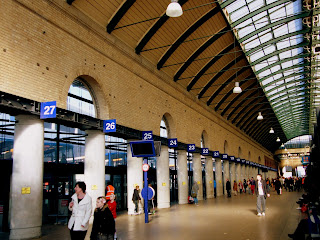At one time English wool was keeping half of Europe warm. The export of fleeces through Hull was started by monks who farmed sheep on the Wolds, chalk hills to the north of the city, and became a major source of income during the middles ages and later. This building on South Church Side was once a wool exchange during the late 19th century; above the door there's a sheep being weighed. Nowadays the wool trade has gone and the building houses a printing business.
Thursday, 11 April 2013
Wednesday, 10 April 2013
Barrel Vaults
The train station was built in the 1840s and later extended in 1904 to have five of these barrel vaults. One of them now forms the bus station that I showed yesterday, three are in use as train platforms and this one seems to be little more than a covered car park.
Tuesday, 9 April 2013
Bus-Passenger Interface Experience
This is Hull's bus station, it's a replacement bus station for the one they knocked down to build a shopping mall a few years ago. You can see for yourself that it's a miracle of modern design. See how, if your bus goes from say door 27 and it's rush hour and the place is full, well, just how easy it will be to push your way through 20 or so different queues while carrying your shopping. Oh yes sir, a lot of thought went into the lay out of this place.
Monday, 8 April 2013
Vacant
Across the street from yesterday's building, which you can see reflected in the window, sits the old Radio Humberside offices and studios. They were situated above the now closed Post Office. If I was to say the building was empty and 'to let' you would not be at all surprised. Radio Humberside now broadcasts from the BBC buildings near Queens Gardens.
I just realised that I've posted another shot from Chapel Street in March last year and that, too, was of an empty building, a bank. It's still empty.
Sunday, 7 April 2013
Chapel Street
There is no sign of the 1,500 seat Provident Chapel that gave this street its name. No sign either of the brewery that stood at the end of it. Little Queen Street no longer curves round and joins it half way down. The chapel was built in 1797. One description has it as being "almost hidden from view at the end of Hope Street". The last service was held in 1903, it later became a warehouse destroyed, as was much of this area, in the blitz. History has not been kind to Chapel Street which is now just a short almost stubby little street connecting Paragon Street and Jameson Street, building the latter took away the northern end and most of Little Queen Street. Nowadays it seems to be almost entirely shut and available for let. This arch is part of Queen's House built out of the post war rubble and stands just about on the site of the old chapel.
Saturday, 6 April 2013
Water trough
This old water trough stands in a hollow created by hundreds of hooves over the years as the commoners' cattle seek to slake their thirst in the heat of Summer. It's next to the old black mill that I showed last week when the heat of Summer was the last thing I was thinking about; avoiding hypothermia was my main concern.The cattle aren't allowed on the common until May; hopefully it will be a bit warmer by then.
More monochrome stuff at the Weekend in Black & White here.
More monochrome stuff at the Weekend in Black & White here.
Friday, 5 April 2013
Going downhill on Ferensway
In what used to be the C&A store that closed because the parent company withdrew from the UK and later became TJ Hughes' store that went bust in the 'great recession' here's Poundland. A shop where every item costs £1. Do you see any progress here? A mid-range clothing firm becomes a down market retailer becomes the bottom feeder of price-point retailing. Poundland is successful with nearly 3 million customers a week and stores across the UK but then if you get some of your staff free from the Government under the workfare scheme that is bound to help with the bottom line [ 1 ].
Subscribe to:
Comments (Atom)






